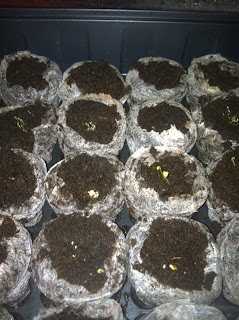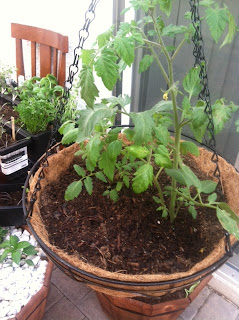I've been working very hard lately to keep lots of little plant lives alive! I've never really had much of a green thumb, but so far, there's only been one casualty (sorry dill). Since I stopped working nights and had a little more time on my hands, I really wanted to start growing some of my own produce. I especially wanted to have an herb garden. Fresh herbs can be expensive to buy, but they are such a great addition to so many dishes and I love cooking with them. So I decided growing them would be really awesome.
I also wanted to make my garden portable since I'll be moving in a few months. So I got some window boxes to plant my lettuce and herbs, some big barrels to plant my peppers and zucchini, a little pot for my aloe vera, a dish for some wheatgrass, and some hanging baskets for tomatoes and lavender. I went a little crazy and planted a lot of stuff so I'll need to thin out the little window boxes when the plants get bigger, but for right now they're fine.
I've been so excited to take on this project and grow my little garden. It's fun to see the seeds sprout their little green leaves and then turn into real plants! My herbs are getting really full and I can use them in my cooking now. My lettuce leaves are still too tiny to use, but hopefully they will grow big and strong soon. It's actually been a pretty relaxing and therapeutic process. It takes patience, which I generally have very little of, but it's really fun to watch. I did a lot of research and found that you can grow a lot of things by container gardening, so once I get the hang of it, I want to grow carrots and onions and all kinds of stuff, but that will probably have to wait for San Diego.
Here's what I did for my portable little garden. I ended up planting oregano, sweet basil, Thai basil, mint, rosemary, thyme, lemon balm, chives, cilantro, parsley, six varieties of lettuce and greens, chamomile, lavender, quinoa, zucchini, jalepenos, bell peppers, grape and roma tomatoes, aloe vera, wheatgrass, and strawberries! I bought some of the herbs as plants and some as organic heirloom seeds. The lettuce I bought all as organic seeds. The tomatoes, peppers strawberries, and aloe I bought as plants that just needed to be potted. I also bought a lot of organic potting soil and some organic peet pods to sprout my seeds. Those were basically in a tray of 72 little pods of soil that you put the seeds in until they sprout.
I decided the arrangement that I wanted to plant everything in, and got started. For the plants, I just potted them in their various containers, but the seeds took a little more work. For everything except the wheat grass, I had to read the labels and do a little research and figure out the best way to get them to sprout. Some required soaking for different periods of time, they all required a different number of seeds per pod, and different watering schedules so I had to keep track of which seeds were where and what they all needed. After a few days, I saw little peaks of green poking through the soil. Once the sprouts were big enough, I transported those to the window boxes as well. I kept them inside until they grew a little stronger, then I moved them outside. For the wheatgrass, I just filled its container with soil and sprinkled the seeds over top, then a little more soil. Within days, the grass started growing, and now it's about 8 inches tall, and I juice it into my morning juice!!
Now that I have a robust little herb garden, I can use it in my recipes! Here's one that I can't stop eating lately!
Quinoa Tabbouleh
1 cup quinoa, uncooked
2 cups water
1 cup fresh parsley, chopped
1/4 cup fresh mint, chopped
1 cup kale, chopped
1 cucumber, diced
1 roma tomato, diced
1 green onion, chopped
2 cloves garlic, minced
juice and zest of 1 lemon
2 tbsp olive oil
salt and pepper
Add the quinoa and water to a saucepan. Cover and bring to a boil, then turn the heat down to a simmer. Cook for about 12-15 minutes until all the water has been absorbed. Let this stand, covered, while you prepare the remaining ingredients. Mix everything into a big bowl, and it's ready to eat! Refrigerate the leftovers (if you don't eat it all!). It gets even more delicious the longer it sits so it's really yummy the next day. It's not traditionally made with quinoa or kale, but quinoa cooks really fast so I use it for everything, and I had kale in my fridge that needed to be used so there you go. That's what is great about this salad, you can add whatever you like or have on hand.
I hope you enjoy and I've inspired you to maybe grow a little herb garden yourself. You don't have to go all crazy and grow as much as I did, but you can even bring a little green into your life and grow some herbs on your countertop! Good luck green-thumbed friends :)










